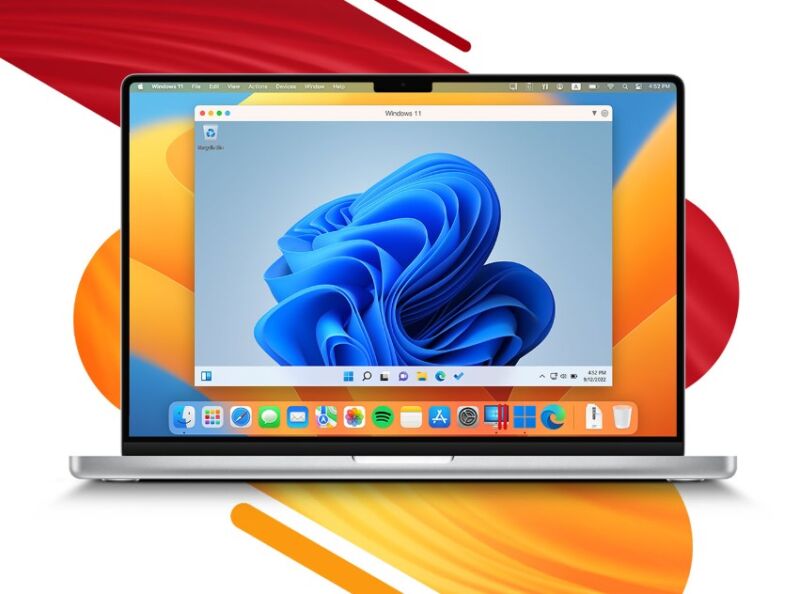

Microsoft officially blesses Parallels as a way to run Windows on M1, M2 Macs
source link: https://arstechnica.com/gadgets/2023/02/microsoft-officially-blesses-parallels-as-a-way-to-run-windows-on-m1-m2-macs/
Go to the source link to view the article. You can view the picture content, updated content and better typesetting reading experience. If the link is broken, please click the button below to view the snapshot at that time.

it's official —
Microsoft officially blesses Parallels as a way to run Windows on M1, M2 Macs
Parallels previously used Insider Program loophole to support Windows installs.
Andrew Cunningham - 2/16/2023, 6:00 PM

In the absence of a version of Boot Camp that runs on Apple Silicon Macs, the best way to run Windows on them has been to use a virtualization app like Parallels or (more recently) VMware Fusion. The problem is that, until now, the Arm version of Windows that runs on Apple Silicon Macs hasn't technically been allowed to run on anything other than Arm PCs that come with it due to Microsoft's licensing restrictions.
These licensing problems haven't technically stopped people from running the Arm version of Windows on other hardware, including Apple Silicon Macs and the Raspberry Pi, but it could be more of an issue for IT managers who wanted to deploy Windows on Macs without worrying about legal liability.
Today, Microsoft is formally blessing Parallels as a way to run the Professional and Enterprise versions of Windows 11 on Apple Silicon Macs. The Arm version of Windows running under Parallels has some limitations—no support for DirectX 12 or newer OpenGL versions, no support for the Linux or Android subsystems, and a few missing security features. But it can run Arm-native Windows apps as well as 32- and 64-bit x86 apps thanks to Windows 11's x86-to-Arm code translation features. Pretty much anything that isn't a game should run tolerably well, given the speed of Apple's M1 and M2 chip families, though there are still weird edge cases for specific apps, and hardware that requires specialized drivers to work in Windows may not support the Arm version.
Parallels has allowed the installation of Windows for a while now, but it was always using a Windows Insider Program loophole that allowed installation without activation. Starting today, users can run the standard release versions of Windows 11 Pro and Enterprise with full support from Microsoft.
For admins or power users who need a more centralized, easier-to-manage way to deploy Windows on these Macs, or who simply want to run Windows without Parallels' technical limitations, Microsoft recommends using Windows 365 Cloud PCs instead. These plans are expensive but save you the trouble of installing and configuring Windows on each Mac you need to run Windows on. They won't consume as much local storage space or RAM as a virtualized copy of Windows running in Parallels.
AdvertisementWill we ever get Boot Camp for Apple Silicon Macs?
Nothing in today's reveal precludes Microsoft and/or Apple from announcing, at some far-off date, that they will support running Windows directly on Apple Silicon Macs. But the technical barriers to running Windows on these Macs remain high and resolving the problems is difficult to justify, given how few users would likely take advantage of the feature in the first place.
The Asahi Linux project is instructive here. We know from the Asahi team that Apple has no restrictions on running third-party operating systems on Apple Silicon Macs. But Apple doesn't provide any support for its hardware beyond that; the Asahi team has been painstakingly building Linux drivers for Apple's hardware from scratch for years, and things like Wi-Fi, sound, and basic graphics acceleration are still very much works in progress.
"Apple's approach to third-party OSes is essentially 'have fun,'" explains the Asahi Linux Introduction to Apple Silicon. "We do not have any expectations of direct support, documentation, or additional development effort from them, nor do we expect them to attempt to hinder third-party OSes in any deliberate way. They have explicitly developed the ability to securely run third-party OSes and bootloaders on these machines, and left the rest to us."
To run a fully functional copy of Windows on Apple Silicon Macs, someone would need to re-create this driver work for Windows, too.
Apple provided some Windows drivers for Intel Macs for components like its mice and trackpads. But because Intel Macs were mostly just PCs under the hood, the company could rely on Intel, AMD, Nvidia, Broadcom, and other companies to actually provide drivers for most of the important components. That wouldn't be the case for Apple Silicon Macs, and there's really no good reason why Apple would spend the time and resources to develop and maintain alternate graphics, networking, and chipset drivers just so a handful of users could run a competitor's operating system.
We've asked Microsoft if it has anything new to share about running Windows directly on Apple Silicon Mac hardware and the company says it has "nothing further to share" on that front. But today's announcement is another signal that virtualization and cloud computing are the way forward for people who need to run Windows apps on their Mac; if you're still hoping for an Apple Silicon version of Boot Camp, it's time to start moving on.
Recommend
About Joyk
Aggregate valuable and interesting links.
Joyk means Joy of geeK